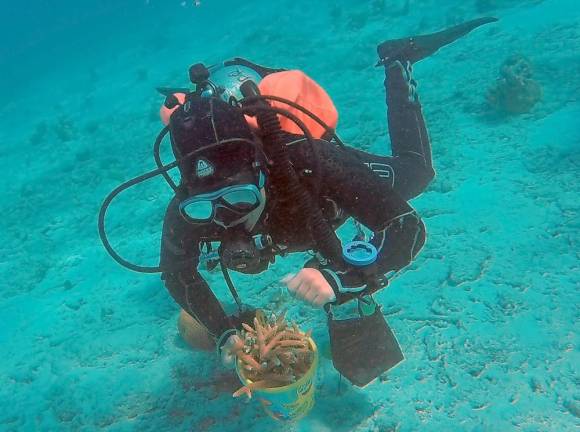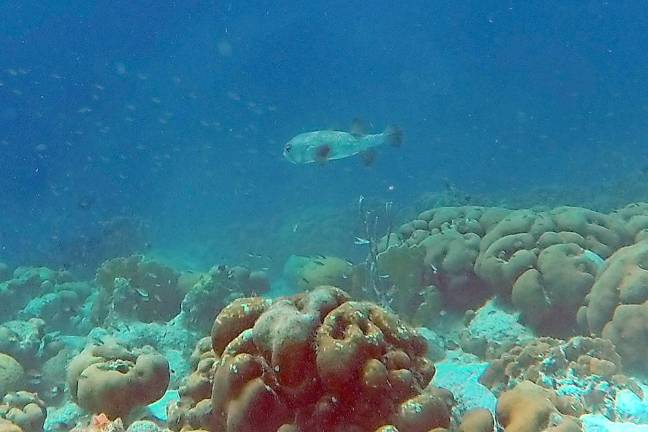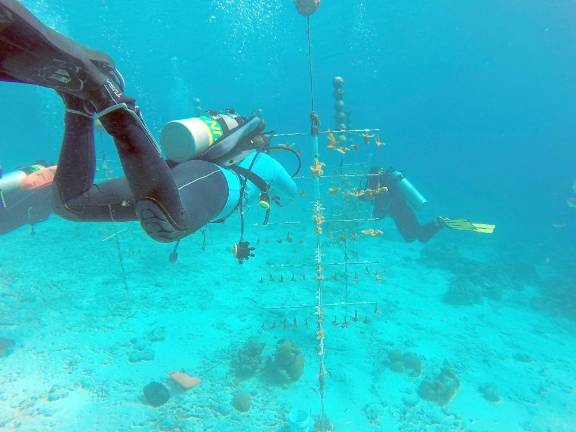What I learned from my month-long fight with fire coral
Dingmans Ferry. Each of us needs to take concrete action to preserve our precious resources and restore lost ecosystems. Preaching environmentalism and sustainability from a keyboard is not a substitute for getting your hands dirty and doing the work.



After 11 years at Pocono Environmental Education Center, I recently took a one-month sabbatical to undertake coral reef restoration work in Bonaire -- an island municipality of the Netherlands in the Caribbean, off the coast of Venezuela. My goals were to assist in the amazing restoration of staghorn and elkhorn corals on the island’s reef and to recharge. My trip was an overwhelming success, and the amazing PEEC staff had no problem keeping the place running without me -- for which I am grateful. The trip taught me many lessons, both expected and surprising.
Coral reef restoration work is really just gardening underwater -- you take cuttings from existing corals, grow them in nurseries (PVC and fiberglass underwater “trees”), and then transplant the more mature coral fragments from the trees onto the reef itself. Most days I was scuba diving twice a day doing coral restoration dives. Basically, I did whatever the Reef Renewal Bonaire staff needed done and they thought I was competent to do. I cleaned coral trees of algae and fire coral (which stings if you touch it), transplanted coral cuttings within the nursery, outplanted coral onto the reef, did some water testing collection, built some new nursery trees and underwater structures on the reef -- did I mention I scraped, chiseled and pried off fire coral?
The average time underwater was 85 to 100 minutes per dive. Lesson number one, 79°F water is cold after an hour and a half, when you are hovering horizontally in place. Fire coral is tenacious and it would be a lot easier if we were restoring the reef by cultivating fire coral instead of scraping it off our nurseries. The reason we do is so that the staghorn and elkhorn have ideal growing conditions. There is a certain zen to cleaning coral trees. It is repetitive, but never the same. The task is unending, as the algae and fire coral grow back quickly and as soon as the nurseries are clean, you need to start over at the beginning.
The results, however, were undeniable. A staghorn coral outplanting from five years ago, at the Jeff Davis dive site, was enormous and flourishing. Not just the coral itself, but the young fish and all the other underwater inhabitants of the marine ecosystem were thriving. The shelter the coral provided anchored everything, much as the forests around PEEC serve the same purpose.
While much of the reef around Bonaire is a marine preserve, some of the corals have degraded over the years through a combination of natural and human causes. Storm surge, coral disease, the lack of sea urchins to eat the algae, human development, and overall global climate change have all contributed to this biodiversity loss. But what became clear is that with some thoughtful and dedicated restoration work, we can bring back some of what has been lost.
Divers can’t replant the entire reef in Bonaire, let alone reefs throughout the world, as the task is too vast. However, if we can create pockets of healthy coral (think underwater national parks with reforestation programs), the hope is that the coral is capable of restoring itself with its annual spawning. The restoration work uses genetic tracking and controlled trial and error to help replant the genotypes of coral that are most hardy in specific conditions and locations.
The most important lesson from my month volunteering is that each of us can make a difference and improve and preserve the planet for the next generation. You don’t have to spend hours underwater or fight with fire coral (unless you like that sort of thing), but you can’t just talk about taking action or complain that governments or others don’t do things. Each of us needs to get out and take concrete action, whether that is preserving the precious resources we have or restoring some of the ecosystems we have lost. Preaching environmentalism and sustainability from a keyboard is not a substitute for getting your hands dirty and doing the work.
That is why Reef Renewal Bonaire and PEEC are two of those amazing places, where hands-on interaction with nature actually produces results. My message is one of hope, but the work is hard, it can be repetitive, it is not always fun, and sometimes it stings -- but that is where change is made and where the lessons are learned.
Editor's note: Jeff Rosalsky is the executive director of the Pocono Environmental Education Center (PEEC) in Dingmans Ferry, Pa.